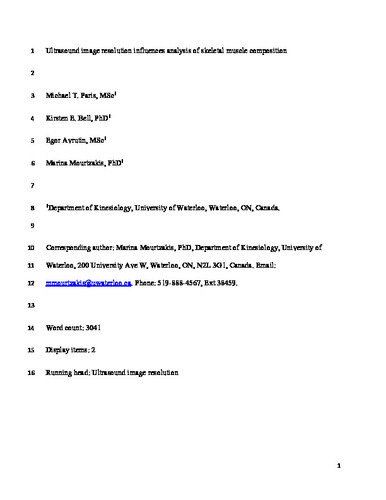| dc.contributor.author | Paris, Michael | |
| dc.contributor.author | Bell, Kirsten Elizabeth | |
| dc.contributor.author | Avrutin, Egor | |
| dc.contributor.author | Mourtzakis, Marina | |
| dc.date.accessioned | 2023-05-10 13:41:42 (GMT) | |
| dc.date.available | 2023-05-10 13:41:42 (GMT) | |
| dc.date.issued | 2020-06-03 | |
| dc.identifier.uri | https://doi.org/10.1111/cpf.12636 | |
| dc.identifier.uri | http://hdl.handle.net/10012/19432 | |
| dc.description | This is the peer reviewed version of the following article: Paris, M. T., Bell, K. E., Avrutin, E., & Mourtzakis, M. (2020). Ultrasound image resolution influences analysis of skeletal muscle composition. Clinical Physiology and Functional Imaging, 40(4), 277–283, which has been published in final form at https://doi.org/10.1111/cpf.12636. This article may be used for non-commercial purposes in accordance with Wiley Terms and Conditions for Use of Self-Archived Versions. | en |
| dc.description.abstract | Introduction: Analysis of muscle composition using ultrasound requires standardization of several equipment settings (i.e. gain). However, the influence of image resolution, which is altered by imaging depth, on measures of muscle composition is unknown.
Methods: We analysed rectus femoris muscle composition using ultrasound images captured from 32 males and females (aged 28 ± 5 years) at depths of 9.0, 7.3, 5.9 and 4.7 cm. The transducer's orientation was fixed using a clamp during image acquisition to minimize movement. Across each image resolution, a region of interest encompassing the same anatomical area within the muscle was used for muscle composition analysis. Muscle composition was analysed using a combination of first-, second- and higher-order texture features. Muscle composition agreement across image resolutions was evaluated using a one-way ANOVA and intraclass correlation coefficients (ICC).
Results: Most muscle composition features displayed differences due to image resolution (p < .05). ICCs demonstrated poor-to-good agreement across different image resolutions. In general, higher resolution images (i.e. shallower imaging depth) demonstrated better agreement (ICC > 0.90) compared to lower resolution images.
Conclusions: Ultrasound image resolution influences muscle composition analysis. Image resolution should be fixed within and between individuals when evaluating muscle composition using ultrasound. | en |
| dc.description.sponsorship | This research was funded by the University of Waterloo's Network for Aging Research | en |
| dc.language.iso | en | en |
| dc.publisher | Wiley | en |
| dc.relation.ispartofseries | Clinical Physiology and Functional Imaging; | |
| dc.subject | ultrasound | en |
| dc.subject | muscle composition | en |
| dc.subject | echo intensity | en |
| dc.subject | body composition | en |
| dc.subject | echogenicity | en |
| dc.subject | muscle quality | en |
| dc.subject | skeletal muscle composition | en |
| dc.title | Ultrasound image resolution influences analysis of skeletal muscle composition | en |
| dc.type | Article | en |
| dcterms.bibliographicCitation | Paris, M. T., Bell, K. E., Avrutin, E., & Mourtzakis, M. (2020). Ultrasound image resolution influences analysis of skeletal muscle composition. Clinical Physiology and Functional Imaging, 40(4), 277–283. https://doi.org/10.1111/cpf.12636 | en |
| uws.contributor.affiliation1 | Faculty of Health | en |
| uws.contributor.affiliation2 | Kinesiology and Health Sciences | en |
| uws.typeOfResource | Text | en |
| uws.peerReviewStatus | Reviewed | en |
| uws.scholarLevel | Faculty | en |

